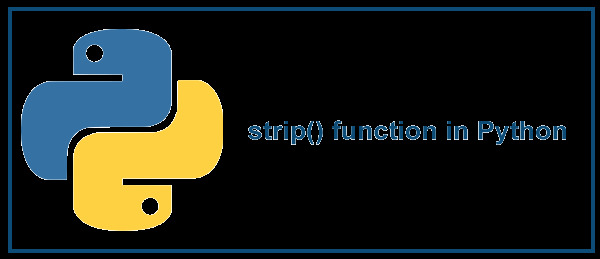strip() 函數是 Python 的預定義庫函數。它用於通過刪除傳遞給 strip() 函數的前導和尾隨空格、字符和符號來返回原始字符串的副本。換句話說,它是 Python 字符串 strip() 函數,它通過將一組字符指定給 strip() 函數作為參數,從字符串的左端和右端刪除字符。默認情況下,如果沒有參數傳遞給 strip() 函數,它會從開始和結束字符串中刪除空格。

用法
strip( 'characters' )參數:
- strip ('chars'):strip() 參數是可選參數。因此,如果程序員沒有將任何參數傳遞給 strip() 函數,它將從字符串中刪除開始和結束空格。
- 如果給定參數的集合傳遞給 strip() 函數,它會從原始字符串中刪除字符或符號。
返回值:它通過從原始字符串中刪除字符集或空格來返回原始字符串的副本。
使用 strip() 函數從給定字符串中刪除字符或符號
讓我們考慮一個示例,通過從 Python 中的給定字符串中刪除前導或尾隨字符來執行 strip() 函數。
剝離文件
strinput = " $$$$$ No. 1 Welcome to JAVATPOINT!! No. 1 $$$ "
# use strip() function to remove the set of characters
res = strinput.strip ( ' $No. 10 !' ) # store result into res variable
print ( " Given string is:", strinput)
print ( " After removing the set of characters:", res)
str3 = ' 1 11 111 111 1111 Learn Python Programming Tutorial 1111 111 11 1 '
str4 = str3. strip ( '1' )
print (" \n Given string is ", str3)
print (" Stripping 1 from both ends of the string using strip ('1') function ", str4)
# define new string
str5 = '++++++Python Programming Tutorial****** $$$$$'
print ("\n Given string is = ", str5)
# use strip function to remove the symbols from both ends
str6 = str5. strip ( ' $*+' )
print (" Stripping the '+', '*' and '$' symbols on both sides of the string is = ", str6)輸出
Given string is: $$$$$ No. 1 Welcome to JAVATPOINT!! No. 1 $$$
After removing the set of characters: Welcome to JAVATPOINT
Given string is 1 11 111 111 1111 Learn Python Programming Tutorial 1111 111 11 1
Stripping 1 from both ends of the string using strip ('1') function 1 11 111 111 1111 Learn Python
Programming Tutorial 1111 111 11 1
Given string is = ++++++Python Programming Tutorial****** $$$$$
Stripping the '+', '*' and '$' symbols on both sides of the string is = Python Programming Tutorial
使用 strip() 函數從給定的字符串中刪除空格
讓我們考慮一個示例,通過從 Python 中的給定字符串中刪除前導或尾隨空格來執行 strip() 函數。
Strip2.py
str1 = ' Welcome to the World! '
# print the original string
print (' Given string is:', str1)
# use strip() function to remove whitespace
str2 = str1.strip()
print(" After removing whitespaces from an original string:", str2)
str3 = ' Learn Python programming '
# print the original string
print (' Given string is:', str3)
# use strip() function to remove whitespace
str4 = str3.strip()
print(" After removing whitespaces from an original string:", str4)輸出
Given string is: Welcome to the World! After removing whitespaces from an original string: Welcome to the World! Given string is: Learn Python programming After removing whitespaces from an original string: Learn Python programming
在上麵的程序中,我們使用 strip() 函數從給定字符串的開頭和結尾刪除空格,但它不會刪除字符串之間的空格。
使用 strip() 函數從用戶獲取任何字符串並刪除任何字符或符號的程序
程序文件
str1 = input( " Enter the string ") # take a string
print (" Your string is ", str1)
ch = input (" Enter any character or symbol that you don't want to see in the string ")
res = str1.strip (ch)
# print the string after using a strip() method
print (" After performing the strip() function, \n Your string is ", res)輸出
Enter the string *** $$ Welcome to JavaTpoint. Learn Python programming !!! && Your string is *** $$ Welcome to JavaTpoint. Learn Python programming !!! && Enter any character or symbol that you don't want to see in the string * $ Wel ! & After performing the strip() function, Your string is come to JavaTpoint. Learn Python programming
為什麽使用 Python strip() 函數?
以下是使用python strip函數的原因:
- 它有助於根據傳遞給 strip() 函數的字符從原始字符串的前導和尾隨中刪除字符。
- 如果用戶沒有將任何字符傳遞給 strip 函數,默認情況下,它隻會刪除字符串兩端的空格。
- 如果原始字符串的開頭或結尾沒有空格,則返回原始字符串而不對其進行修改。
- 如果傳入的字符與原始字符串不匹配,strip 函數返回原始字符串。
結論:
在上麵的話題中,我們了解了 Python 庫的 strip() 函數。它是一個 strip() 函數,用於去除原始字符串開頭和結尾的字符或空格。但是,如果用戶沒有將任何字符傳遞給 strip() 函數,它隻會從主字符串的開頭和結尾刪除空格。
相關用法
- Python string strip()用法及代碼示例
- Python string.octdigits用法及代碼示例
- Python string.whitespace用法及代碼示例
- Python string capitalize()用法及代碼示例
- Python string.punctuation用法及代碼示例
- Python string center()用法及代碼示例
- Python str() vs repr()用法及代碼示例
- Python strftime()用法及代碼示例
- Python str()用法及代碼示例
- Python Scipy stats.cumfreq()用法及代碼示例
- Python Scipy stats.nanmean()用法及代碼示例
- Python Scipy stats.gengamma()用法及代碼示例
- Python Scipy stats.dweibull()用法及代碼示例
- Python Scipy stats.hypsecant()用法及代碼示例
- Python scipy stats.expon()用法及代碼示例
- Python Scipy stats.f()用法及代碼示例
- Python Scipy stats.genexpon()用法及代碼示例
- Python Scipy stats.genextreme()用法及代碼示例
- Python Scipy stats.alpha()用法及代碼示例
注:本文由純淨天空篩選整理自 strip() function in Python。非經特殊聲明,原始代碼版權歸原作者所有,本譯文未經允許或授權,請勿轉載或複製。
